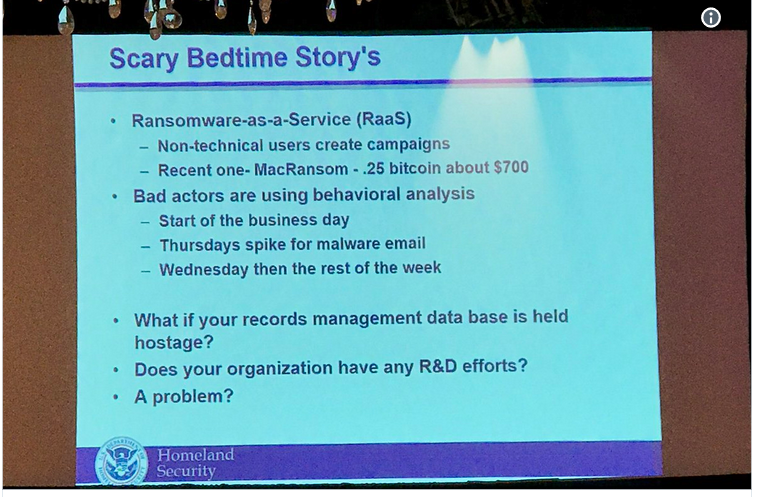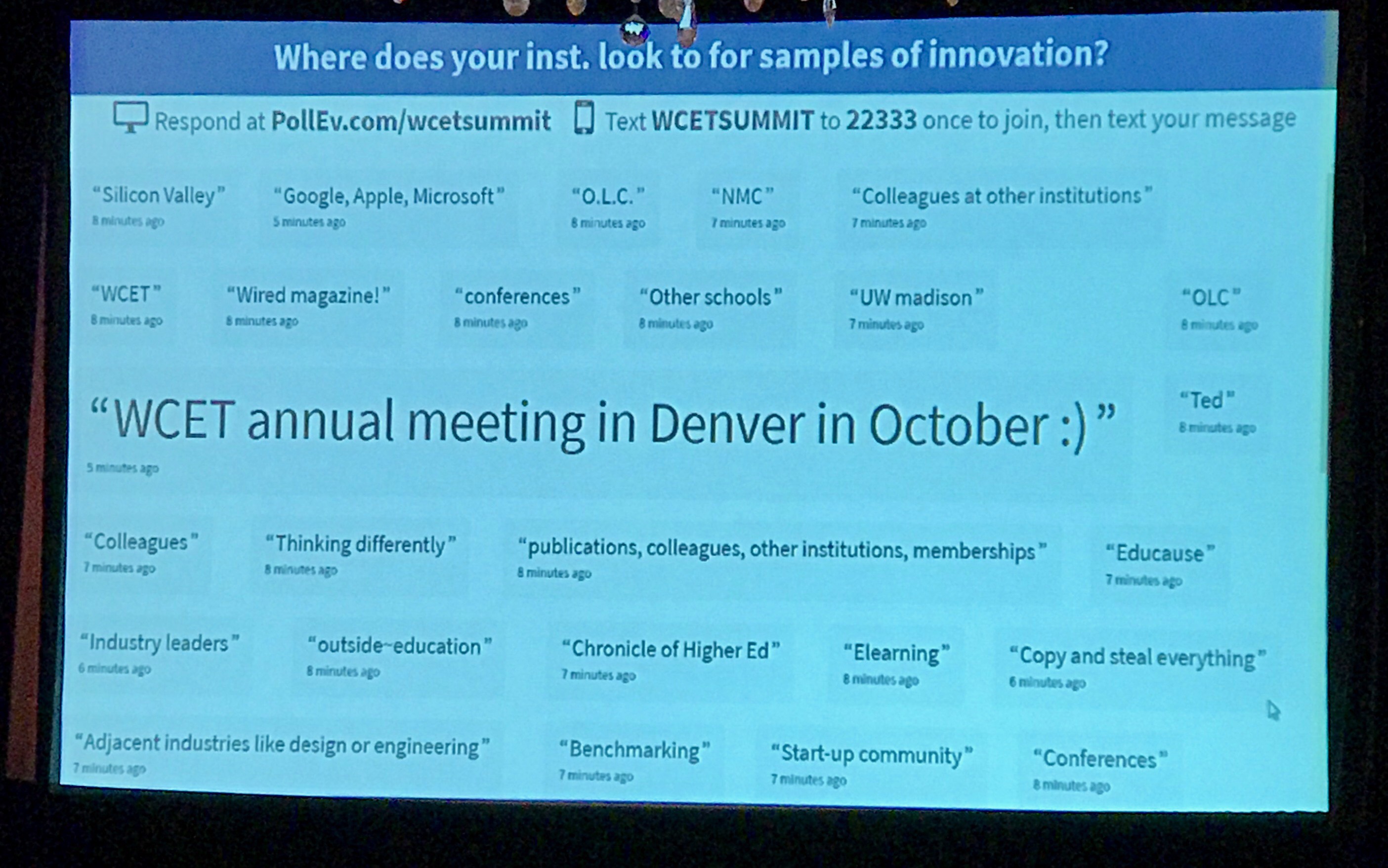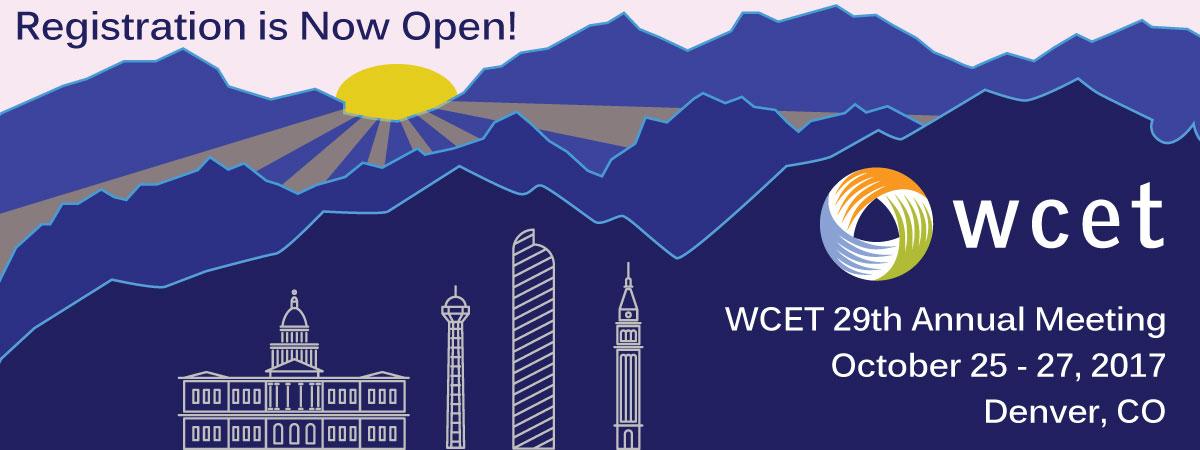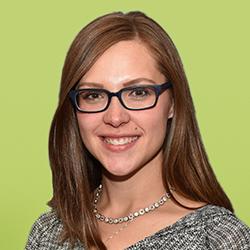Focus on Student Success - WCET Summit '17 Recap
Published by: WCET | 6/23/2017
Tags: Innovation, WCET Summit
Published by: WCET | 6/23/2017
Tags: Innovation, WCET Summit
WCET’s 6th Leadership Summit engaged institutional leaders in strategic discussions regarding alignment and support of their institution’s human capital and technology investments,  and how to develop a content strategy to sustain innovation in teaching and learning. In my opinion, boy was it successful!
and how to develop a content strategy to sustain innovation in teaching and learning. In my opinion, boy was it successful!
This was my very first WCET Leadership Summit, and I thoroughly enjoyed the experience. From the invigorating sessions and outstanding conversations, fun outings complete with concerts or yummy dining options, to the thrillingly active social media backchannel. Today, I’d like to recap the event and bring up some of the topics that I hope will continue to inspire future conversations, project ideas, and events.
The Summit started with Nick White, Director, Competency Based Learning Solutions for Capella University and chair of the WCET Steering Committee, facilitating a panel with Jeff Borden (Chief Innovation Officer, Saint Leo University) and Michelle Weise (Executive Director, Sandbox Collaborative, Southern New Hampshire University) on driving institutional innovation. We learned about what Nick hates when it comes to innovation and the Twitter backchannel fired up rather quickly (and remained very active, check out the Storify). Michelle and Jeff discussed innovations on their campuses: Southern New Hampshire University’s Sandbox Collaborative and Saint Leo University’s Lions SHARE. Both noted that innovation is hard! To encourage innovation, they recommended bringing people on board slowly, raising awareness of innovators in action, and making sure to reward and celebrate failure (meaning, take advantage of failure as a learning opportunity).
Want to experience the magic of that session? Watch the recording of this session.
The breakout sessions this year included presentations and interactive discussions about hiring and cultivating talented employees, designing teaching and learning centers, aligning investments to support student success, educational content strategies, and data analytics. For more information on the presentations and the presenters, please check out the summit agenda.
Lauren Mason Carris -Western Governors University, Pat James -California Communication Colleges Online Education Initiative, Laura Pedrick -UWM Online
The focus on student success was clear during this session, and is accomplished by ensuring we have the right talent on the team and we take the time and the resources to develop that talent.
The presenters opened the session by telling stories about their experiences with talent management and mentoring. They emphasized the creation of a talent focused organization. We must look for opportunities to re-skill or re-motivate (vs. disciplining), model good leadership or work habits, and provide space to our team members to grow. Student success should be the guiding mission for your team. Pat commented that she always makes sure to ask one question when considering new projects, programs or initiatives. Does it support student success? If it doesn’t support student success, why are you doing it?
MJ Bishop -University System of Maryland, Christina Anderson -Wiley Education Services, Jay Hollowell – MaxKnowledge, Inc.
Centers for teaching and learning not only provide development opportunities for faculty, but can enable innovation. The role of these centers is not to fix broken faculty, but to share what’s working to improve student learning.
The learning environment of today is changing from sitting in a seat, listening to select information, to an environment of experiences and unlimited access to information. Today’s learners have more life experience, are more diverse, and are “on” 24/7. How can we prepare to meet the needs of these students?
There are new and emerging faculty roles today as well. They are now planners, preparers, facilitators, coaches, and evaluators. Institutions are reorganizing to better support faculty and students in technology enabled learning initiatives.
Rhonda Blackburn –LoudCloud Systems, Stefanie Crouse -Montgomery County Community College, Paul Thayer -Colorado State University
How do you align your resource investments to ensure you make a difference to student retention and completion?
During the general session, Paul talked about how advising at Colorado State was broken, so they created a new model. CSU created a unified vision connected to student success and made sure they had top level support (five vice presidents) and institution-wide involvement.
Rhonda asked, how do we ensure student success for online students? What services are different for online students and what services the same? Most important, what needs to be improved? Rhonda also provided a wonderful resource with a checklist of student support services, including “ethical services,” which includes academic integrity.
Lastly, we discussed redesigning advising at Montgomery County Community College. Advising had been like urgent care: quick visits with different advisors each time. After the redesign, students were assigned advisors based on their major/program of study. Montgomery adopted a wholistic approach including educational and career planning. They based their model on the SSIPP model for serving students: Sustained, Strategic, Integrated, Proactive, and Personalized – from the Community College Research Center at Teachers College at Columbia University.
I enjoyed their closing activity to determine who would be “at your table” when starting something new on campus. We decided that we need to bring in IT, institutional research, marketing, advising, students, etc. into the room to talk about the problem and brainstorm solutions.
Just before and after lunch we attended general sessions, the first of which focused on tackling the higher education data security and privacy challenge. We were introduced to the topic by John Lopez, WICHE. Sadly, the tales of hacking and data loss are not just scary bedtime stories.  We heard about Homeland Security’s Cybersecurity Advisory Program from Harley D. Rinerson, which can help assess essential cybersecurity performance or check out your cyber hygiene (scan to assess vulnerabilities). We remembered a time when all this tech stuff only kept one person up at night: our institution’s Chief Information Officer. Today, we all must take responsibility for data security. WCET’s Mike Abbiatti reminded us that protecting data is a strategic issue. We can’t talk about innovation in higher education without first talking about cybersecurity.
We heard about Homeland Security’s Cybersecurity Advisory Program from Harley D. Rinerson, which can help assess essential cybersecurity performance or check out your cyber hygiene (scan to assess vulnerabilities). We remembered a time when all this tech stuff only kept one person up at night: our institution’s Chief Information Officer. Today, we all must take responsibility for data security. WCET’s Mike Abbiatti reminded us that protecting data is a strategic issue. We can’t talk about innovation in higher education without first talking about cybersecurity.
We must inform and education our campus communities about data and privacy protection. The new culture of innovation should also be a culture of protection and preparedness. Learn more by watching the recording.
The second general session turned toward fostering innovation through design thinking. Kathleen deLaski, Education Design Lab, introduced us to journey mapping new ideas. They use the map to visualize patterns and understand how ideas blossom or get sidetracked. The Ed Design Lab’s model of design thinking for higher ed innovation includes: understand, ideate, prototype, launch.
Sean Hobson, EdPlus, ASU, believes that successful innovation at ASU has been possible due to a strong vision by a strong and inspiring leader. Their success stems from moving from an institutional focus to a student focused model. This model forced them to develop new partnerships and new values to create and foster those ideas.
Manoj Kulkarni, RealizeIt, commented on the language problem with the verbiage used when discussion innovation. Most people understand the structure or concept of innovation but not the entire process of what it means to innovate. We need to develop a shared meaning of the process of innovation. Miss this session? You’re in luck, because we recorded it!
At the end of the day, Jeff Borden provided an entertaining and thought-provoking recap of day one. I thought his comments about considering innovation without technology were so important. Innovation doesn’t always have to be centered around technology. Miss it? Check out the recording!
Notes from Day 1 of #WCETSummit17 #sketchnotes #ideashapers. Great day. pic.twitter.com/XUMcuflGKw
— Kara Monroe (@knmtweets) June 14, 2017
Group dinners followed for many of us, and, and some of us also attended the outdoor concert at Salt Lake’s Gallivan Center (or listened from our rooms, as the concert was right outside the hotel).
We were welcomed to day two by Kelvin Bentley, the Vice Chair of the WCET Steering Committee and vice president of academic affairs, TCC Connect Campus, Tarrant County Community College District.
Our opening session included lessons on supporting innovation, from a panel that included Stacey VanderHeiden Guney -Aims Community College, Kara Monroe -Ivy Tech Community College, Vernon Smith -American Public University System, Paul Thayer -Colorado State, and facilitated by Luke Dowden -University of Louisiana at Lafayette. Their theme: do you fail at scale or do you pilot to tell? Luke referenced his recent blog on the same title, which inspired the presentation for WCET.  The panelists discussed their successes and failures in innovation. First, Kara’s discussed their recent, faculty led, LMS RFP process and rollout (communication was key). Vernon talked about the iron triangle within higher education (quality, cost, access) and how these cultural constraints can keep us from innovating. American Public University System is a Z degree, zero cost for textbooks, institution. This increases affordability and access for students. Next, we learned about the ACCelerator from Stacey VanderHeiden Guney. Her suggestion was to look “at old things in new ways.” Such as looking at an old shopping mall and turning it into a campus. Paul Thayer described a long-term project (student success initiatives) aimed at increasing graduation rates, especially for low income students. Transformation of advising to academic guidance was a huge part of this project.
The panelists discussed their successes and failures in innovation. First, Kara’s discussed their recent, faculty led, LMS RFP process and rollout (communication was key). Vernon talked about the iron triangle within higher education (quality, cost, access) and how these cultural constraints can keep us from innovating. American Public University System is a Z degree, zero cost for textbooks, institution. This increases affordability and access for students. Next, we learned about the ACCelerator from Stacey VanderHeiden Guney. Her suggestion was to look “at old things in new ways.” Such as looking at an old shopping mall and turning it into a campus. Paul Thayer described a long-term project (student success initiatives) aimed at increasing graduation rates, especially for low income students. Transformation of advising to academic guidance was a huge part of this project.
Hearing about these exceptional programs from these very cool experts (as Luke Dowden named them) was a terrific opportunity. The recording is available for binge watching this weekend!
After a lovely beverage break, we were released for more breakout sessions.
Jason Hales -VitalSource, Shannon Meadows -EdMap, Meredith Schreiber -Chemeketa Community College, Kim Thanos -Lumen Learning
An educational content strategy is an institutional plan for the procurement and delivery of course materials to achieve affordability, access, and retention goals. When developing your content strategy, as advised by Shannon Meadows from EdMap, keep in mind that it should be “flexible to accommodate emerging pedagogical and institution changes, such as personalization, adaptive, interactive content, and/or analytics.”
We discussed using Open Educational Resources as a content strategy. There are some challenges to address when it comes to OER (quality, maintenance, technology, etc.). Kim brought up the example of Cerritos College, where access to personalized learning and OER has helped with their retention (rates increased from 67% to 89%)) and student performance (.75 grade pints better in personalized courses).
Meredith advised that many question her work on OER (because of the potential impact to her job at the bookstore), she says we should think of ourselves as Blockbuster. That’s a distinct perspective! She worked to streamline low cost textbook adoption process and provide direct digital access to content. While this impacted her bookstore revenue, students had access to educational content day one at a reduced price. Remember: Blockbuster. We can work toward this change, keeping student success as our goal, or we can help ourselves become obsolete.
Jason had a similar story. Their model ensures day one access to learning materials at a lower cost. They are facing some issues with content as well such as too rapid of growth, differential pricing, offline access, and data analytics.
Jeff Aird -Salt Lake Community College, Mike Sharkey -Blackboard, Inc
How well does higher ed do at making sure that the data we have is actionable? I’ve always felt that if you don’t have an actionable reason to pull data, then why are you pulling it?
This session focused on how to use our data to identify innovative solutions to higher ed’s biggest issues. We need to progress from descriptive data (simple reports and dashboards), to insights (storytelling and analysis), to action. Data provides opportunities for engagement. We can use the data to redesign courses (and hopefully decrease the need for interventions for at risk students). Data should be used to provide purpose and information to your faculty and staff.
Connie Johnson -Colorado Technical University, Patrick Rossol-Allison -Bill and Melinda Gates Foundation, Bryan Setser -rpkGroup
Innovation involves change, and much of that involves a change in culture. Higher education may need to consider taking a mindset similar to innovators in other industries (like an “intrapreneur” vs and entrepreneur).
Communication during a change process is important. When leading change, we should develop a sense of urgency, provide evidence for why we need to change (especially important when working with faculty), and celebrate success (even the small ones!). You should obtain and analyze data and adapt your plan as you move through the change process. Do quarterly assessments to check the health of your change process…don’t wait to do an autopsy once your initiative failed.
Fantastic #WCETSummit17. Here are my day 2 notes. #ideashapers #sketchnote pic.twitter.com/5RzUkFZYz6
— Kara Monroe (@knmtweets) June 15, 2017
Peter Smith led us through a recap of day two, thank you Peter! He had a few aha! moments during the meeting, and my favorite was his comment about calling students learners instead of students. To me, it is much more empowering to be a learner. Listen to his other aha moments in the recording.
We asked at the end of each day for ideas on how we can help you innovate on your campus. I know the team is looking forward to developing additional resources, initiatives, media, etc. We may reach out to partner with you on some of your ideas!
What did you think about #WCETSummit17? If you loved this event (or were jealous because you couldn’t attend) then you should join us in Denver for the WCET Annual Meeting. Registration just opened!
Enjoy the day,
~Lindsey

Lindsey Downs
Manager, Communications, WCET

1 reply on “Focus on Student Success – WCET Summit ’17 Recap”
[…] June 2017, I had the outstanding opportunity to attend my first WCET Leadership Summit. Last year’s event focused on the essential institutional capacities needed to encourage and lead innovation. I […]